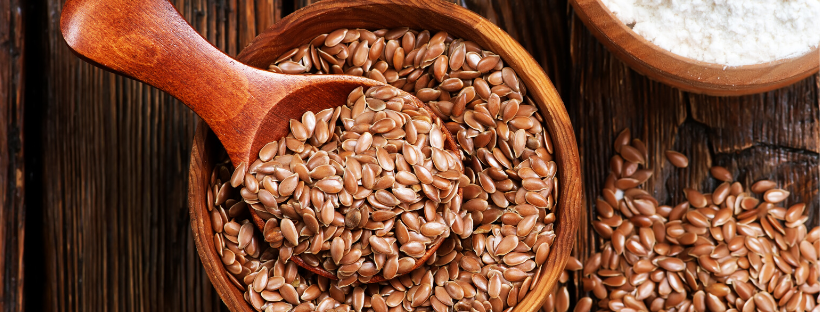by Raphaelle O’CONNOR, PhD
When we think of superfoods, we tend to think of exotic, novel-sounding ingredients as being better than the common products that are readily available such as broccoli, berries, beetroot or oats. This article will focus on one such superfood – flaxseed – which goes by the Latin name ‘Linum Usitatissimum’ and means “most useful”.
I want to take a deep-dive into the make-up and functions of edible flaxseed taking into account its uses from a manufacturer and commercial perspective as it may be of interest to those considering using flaxseed as an ingredient in pending product launches or modifications to existing products.

Flaxseed as an ingredient
Various edible forms of flaxseed are available in the food market – whole flaxseeds, germinated, milled flaxseed, roasted flaxseed and flaxseed oil. It is a multicomponent system with bio-active plant substances such as fat, protein, dietary fibre, soluble polysaccharides, most abundant source of lignans, phenolic and flavonoid compounds (Wang et al., 2017), vitamins and minerals. Due to all these nutrients, flaxseed may provide a lot of advantages such as improved digestion, clearer skin, lower cholesterol and balanced hormones levels, many of which are benefits that are in high demand from modern consumers.
It is commonly known that flaxseeds are high in soluble (mucilage gums) and insoluble (cellulose and lignin) natural fibres that help to sweep out the colon, act as prebiotics, increase bowel movements, regulate blood glucose and cholesterol levels and aid detoxification. What may not be so well established is the adaptogenic effect of increasing and decreasing bowel movement depending on what your body needs. Research suggest that the fibres behave like a soothing film or weak gel that protects the gut lining. This mucilage may also act like a lubricant that facilitates internal transit and movements. Note the optimal pH range for viscosity of flaxseed mucilage is 6-8, the pH environment in human intestines.
In addition to fibres, flaxseed contains fats including significant innate levels of alpha-linolenic acid (ALA, omega-3 fatty acid), proteins (Marambe and Wanasundara, 2017) and is a rich source of ubiquitous lignans (acting both as antioxidants and phytoestrogens involved in the prevention and treatment of heart disease). Early research suggest that lignan-enriched flaxseed powder supplementation may provide beneficial effects such as a reduction in bodyweight and fat accumulation, the lipid profile improvement, and blood pressure control (Park and Velasquez, 2012).
What about formulation?
Flaxseed will contribute to the nutritional label and can also be a highly multifunctional filler and bulking agent which is very relevant in reformulated products with reduced fat or sugar quantities.
With unique water and fat binding and holding capacity, gels made from ground flaxseed have unusual visco-elastic properties upon heating/cooling, changes in pH and shear stress. By adding ground flaxseed to product development and formulations, it gives food scientists, technologists, culinary experts and manufacturers an opportunity to explore original mouthfeel and textures in product categories such as:
- Ready-to-Drink (RTD) or Ready-to-Eat (RTE) functional and nutritional foods and beverages such as porridge, soups and smoothies
- Plant-based desserts
- Yogurt (Ardabilchi Marand et al. 2020)
- Sauces and condiments
- Fresh noodles (Zhu and Li, 2019)
- Baked goods (Kaur et al., 2019; Sęczyk et al., 2017)
- Meat and cheese analogues
- Porridge, soups and smoothies
- Specialised or Senior nutrition products to address targeted medical needs (e.g. dysphagia)
Ground flaxseed that has been hydrated brings viscosity and contains active particles that can be characterised for their natural gelling, foaming, encapsulation and emulsifying agents that can perform well in complex matrices (Nikbakhat Nasrabadi et al. 2020), controlled release and food systems such as foams and gels. These characteristics are likely to perform well in egg-replacement formulation for example or to increase stability and physical appearance of encapsulated or layered food networks.


From a sensory perspective, flaxseed has a light nutty, buttery flavour with little to no smell. Due to their colour, the golden flax seeds can easily be hidden in certain food preparations. This would be very helpful when feeding golden flax seeds to children or picky eaters.
Flaxseed is a versatile food source (Kajla et al., 2015) with many functionalities, health benefits and commercial opportunities to be revealed to those who are willing to embrace the challenges ahead of enhancing bioavailability (e.g. reduce antinutritional factors, Kajla et al. 2015) and emerging commercial opportunities in different industries and categories such as foods, cosmetics, pharmaceuticals and medicine (Liu et al., 2018).
Beyond foods, I can see immediate relevance and applications in natural cosmetics and other fast-moving consumer goods (FMCG) such as toothpaste and shampoos.
What now?
I hope I have triggered your interest and attention by explaining more about this indigenous superfood and the opportunities that a natural adaptogenic fibre has on offer from a product development and innovation perspective.
Are you interested in launching converging products with a clean label or V-label? Developing multi-functional and nutritional foods and beverages? Discovering the power of indigenous ingredients or/and biotransformation?
iNewtrition can help with all of the above by merging clean-science, tech and ingenuity to move the trajectory of integrative wellbeing, health & nutrition for a more integrated and sustainable future. Please email me, Raphaelle, at info@inewtrition.com to discuss in more detail.
References
Ardabilchi Marand, M.; Amjadi, S.; Ardabilchi Marand, M.; Roufegarinejad, L. and Mahdi Jafari, S. (2020) Fortification of yogurt with flaxseed powder and evaluation of its fatty acid profile, physicochemical, antioxidant, and sensory properties. Powder Technology. 359. Pp. 76-84.
Goyal, A.; Sharma, V.; Upadhyay, N.; Gill, S. and Sihag, M. (2014) Flax and flaxseed oil: an ancient medicine & modern functional food. Journal of Food Science & Technology. January 2014.
Kajla, P.; Sharma, A. and Raj Sood, D. (2015) Flaxseed – a potential functional food source. Journal of Food Science & Technology. 52(4). Pp. 1857-1871.
Kaur, P.; Sharma, P.; Kumar, V.; Panghal, A.; Kaur, J. and Gat, Y. (2019) Effect of addition of flaxseed flour on phytochemical, physicochemical, nutritional, and textural properties of cookies. Journal of the Saudi Society of Agricultural Sciences. 18. Pp. 372-377.
Liu, J.; Shim, Y.Y.; Tse, T. J.; Wang, Y. and Reaney, M.J.T. (2018) Flaxseed gum a versatile natura hydrocolloid for food and non-food. Trends in Food Science & Technology. 75. Pp. 146-157.
Marambe, H.K. and Wanasundara, J.P.D. (2017) Protein from flaxseed (Linum usitatissimum L.). in Sustainable Protein Sources. ISBN: 9780128027783.
Moczkowska, M.; Karp, S.; Niu, Y. and Kurek, M.A. (2019) Enzymatic, enzymatic-ultrasonic and alkaline extraction of soluble dietary fibre from flaxseed – A physicochemical approach. Food Hydrocolloids. 90. Pp. 105-112.
Nikbakht Nasrabadi, M.; Hossein Goli, S.A.; Sedaghat Doost, A. and Van der Meeren, P. (2020) Characterisation and enhanced functionality of nanoparticles based on linseed protein and linseed gum biocomplexes. International Journal of Biological Macromolecules. 151. Pp. 116-123.
Park, J.B. and Velasquez, M.T. (2012) Potential effects of lignan-enriched flaxseed powder on bodyweight, visceral fat, lipid profile, and blood pressure in rats. Fitoterapia. 83. Pp. 941-946.
Sęczyk, L.; Świeca, M.; Dziki, D.; Anders, A.; Gawlik-Dziki, U. (2017) Antioxidant, nutritional and functional characteristics of wheat bread enriched with ground flaxseed hulls. Food Chemistry. 214. Pp. 32-38.
Wang, H.; Wang, J.; Qiu, C.; Ye, Y.; Guo, X.; Chen, G.; Li, T.; Wang, Y.; Fu, X. and Hai Liu, R. (2017) Comparison of phytochemical profiles and health benefits in fiber and oil flaxseeds (Linum usitatissimum L.). Food Chemistry. 214. Pp. 227-233.Zhu, F. and Li, J. (2019) Physicochemical and sensory properties of fresh noodles fortified with ground linseed (Linum usitatissimum). Food




Highly energetic article, I loved that a lot.
Will there be a part 2?
my homepage; William
It’s difficult to find well-informed people on this subject, however, you sound like you know what you’re talking about!
Thanks
My site; how does Alpha Femme Keto Genix work
Everything is very open with a clear explanation of the issues.
It was really informative. Your website is useful. Thanks for sharing!
Here is my blog :: https://auvela-skin-care.com